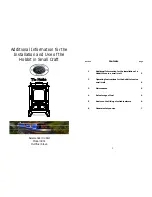
5
3 - Maintenance
2.1
Sweeping
It is important to have the stove and flue swept at least once every 6 months when installed
in a small craft as advised in BS 8511. Chemical cleaners should not be used as a substitute
for sweeping.
Regular inspection and cleaning of the internal components of the stove can indicate if the
chimney requires more frequent cleaning. Any damaged or worn item should be replaced
using original parts from the stove supplier, or compatible with the original part in compliance
with BS 8511.
If the stove has been unused for an extended period (during the summer) the chimney should
be checked by a competent person before use.
The flue should be inspected at least once per year throughout its length for dents, external
damage, internal or external corrosion or obstruction and any damaged item replaced.
Note
All parts that are in direct contact with the fire (grate, Baffle, back and side air boxes) are
considered as normal wear parts. Their life will be dependant on how vigorously the stove is
operated and they must be inspected and maintained on a regular basis. If they become
worn, damaged or not positioned correctly, non wear parts such as the stove top and sides
will be exposed to excessive heat and may be damaged.
2.2 Cleaning the stove
Clean the outside of the stove with a soft brush.
Regularly remove and clean the baffle and back and side air boxes of soot and debris. also
clean the internal surfaces of the stove. The frequency will be dependant on how vigorously
the stove has been fired and what fuel has been used.
Any deposits allowed to build up in this area could reduce the lifespan of the stove.
Note that if required the flue can be accessed for cleaning from inside the stove.
2.3 Gaskets
The rope gaskets in both doors will need regular inspection (at least once per year) to check
the condition and ensure that the doors seal and full control of the air supply to the fire can
be maintained.
2.4 Stove glass
Clean the stove glass only when cool with a specialist glass cleaner. Use of any abrasive
cleaner will scratch the glass and make subsequent cleaning more difficult.
2.5 Cabin Ventilation
Cabin grills and vents should be regularly inspected to ensure they have not become blocked
with debris such as insects, leaves or fluff.
Remember
Maintenance should only be carried out when the stove is cool
If the stove is not to be used for an extended period set both air controls to half open to
allow an airflow through the stove and avoid condensation.
6
4 – Safe storage of fuel
3.1 All solid fuel should be stored dry and away from sources of heat.
3.2
Wood logs should be stowed under cover with adequate ventilation.
3.3
Under no circumstances should fuel be placed on the hearth, or near other sources of
heat
3.4
Solid fuel should not be stored within 600mm of the appliance unless separated by a non
combustible partition.
3.5
Flammable liquids, gas bottles, aerosols etc. should be stored in a separate area well-
away from the appliance and not within the accommodation area.
5
– Advice on the fitting of suitable alarms
Smoke Alarms
At least one suitable and effective smoke alarm should be fitted in a suitable location. Alarms
should be mounted on the deckhead or headlining, at least 300mm from the cabin sides and
within 5m of each protected area of the vessel. On some craft this may mean installing more
than one alarm, and it is recommended to fit units that can be linked together.
The smoke alarm should be capable of waking any occupant sleeping aboard the craft. The
alarm should be tested with this in mind before the final fixing is made.
The smoke alarm should be of the optical or photoelectrical type since these are particularly
sensitive to dense smoke such as produced from a smouldering fire.
The smoke alarm should be fitted with an extra-long life battery and have a hush button to
allow for temporary deactivation.
It should be tested as part of a boaters normal boarding routine.
(For more information ref BS5839-6 and BS EN 14604)
Carbon Monoxide Alarm
Consideration should be given to the fitting of a carbon monoxide alarm suitable for marine
use and certified to BS EN 50291




